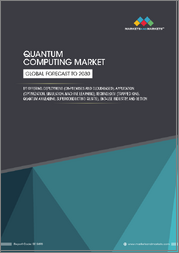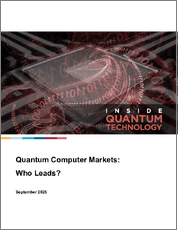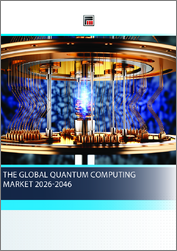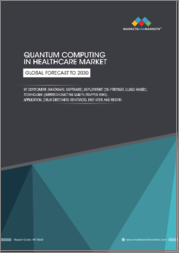
|
시장보고서
상품코드
1770867
클라우드 기반 양자 컴퓨팅 시장 : 세계 산업 규모, 점유율, 동향, 기회, 예측 - 오퍼링별, 기술별, 용도별, 최종사용자별, 지역별, 경쟁별(2020-2030년)Cloud-based Quantum Computing Market - Global Industry Size, Share, Trends, Opportunity, and Forecast, By Offering, By Technology, By Application, By End User, By Region & Competition, 2020-2030F |
||||||
세계의 클라우드 기반 양자 컴퓨팅 시장은 2024년에는 7억 4,251만 달러에 달하며, 2030년까지는 23억 6,531만 달러에 달할 것으로 예측되며, 예측 기간 중 CAGR은 21.30%로 성장할 것으로 예측됩니다.
클라우드 기반 양자 컴퓨팅은 인터넷을 통해 접근 가능한 플랫폼을 통해 양자 계산 기능을 제공하여 사용자가 물리적 하드웨어를 소유하지 않고도 양자 프로세서에 원격으로 접속할 수 있도록 하는 것을 말합니다. 바이너리 상태에 의존하는 고전 컴퓨팅과 달리 양자 컴퓨팅은 여러 상태를 동시에 존재할 수 있는 양자 비트를 활용하므로 처리 능력이 비약적으로 향상됩니다. 클라우드 딜리버리는 높은 인프라 비용을 없애고 전 세계 연구자, 개발자 및 기업이 접근할 수 있도록 함으로써 이 강력한 기술에 대한 접근을 민주화합니다. 양자 컴퓨팅 용도를 지원하는 클라우드 기반 플랫폼을 개발하고 있습니다. 시장 성장의 배경에는 제약, 암호화, 물류, AI 등 산업 전반에 걸쳐 매우 복잡한 문제를 해결해야 할 필요성이 증가하고 있으며, 투자 증가, 산학 협력, QaaS(quantum-as-a-service) 모델의 출현이 지원되고 있습니다.
| 시장 개요 | |
|---|---|
| 예측 기간 | 2026-2030년 |
| 시장 규모 : 2024년 | 7억 4,251만 달러 |
| 시장 규모 : 2030년 | 23억 6,531만 달러 |
| CAGR : 2025-2030년 | 21.30% |
| 급성장 부문 | 시뮬레이션과 모델링 |
| 최대 시장 | 북미 |
주요 시장 성장 촉진요인
각 산업 분야의 컴퓨팅 수요 증가
주요 시장 과제
기술의 미숙함과 하드웨어의 한계
주요 시장 동향
양자 및 고전적 하이브리드 워크플로우의 등장
목차
제1장 솔루션 개요
- 시장의 정의
- 시장의 범위
- 대상 시장
- 조사 대상연도
- 주요 시장 세분화
제2장 조사 방법
제3장 개요
제4장 고객의 소리
제5장 세계의 클라우드 기반 양자 컴퓨팅 시장 전망
- 시장 규모·예측
- 금액별
- 시장 점유율·예측
- 오퍼링별(소프트웨어, 서비스)
- 기술별(트랩 이온, 양자 어닐링, 초전도 양자 비트, 기타)
- 애플리케이션별(최적화, 시뮬레이션과 모델링, 샘플링, 기타)
- 최종사용자별(항공우주·방위, BFSI, 헬스케어, 자동차, 에너지·전력, 화학, 정부, 기타)
- 지역별(북미, 유럽, 남미, 중동 및 아프리카, 아시아태평양)
- 기업별(2024년)
- 시장 맵
제6장 북미의 클라우드 기반 양자 컴퓨팅 시장 전망
- 시장 규모·예측
- 시장 점유율·예측
- 북미 : 국가별 분석
- 미국
- 캐나다
- 멕시코
제7장 유럽의 클라우드 기반 양자 컴퓨팅 시장 전망
- 시장 규모·예측
- 시장 점유율·예측
- 유럽 : 국가별 분석
- 독일
- 프랑스
- 영국
- 이탈리아
- 스페인
제8장 아시아태평양의 클라우드 기반 양자 컴퓨팅 시장 전망
- 시장 규모·예측
- 시장 점유율·예측
- 아시아태평양 : 국가별 분석
- 중국
- 인도
- 일본
- 한국
- 호주
제9장 중동 및 아프리카의 클라우드 기반 양자 컴퓨팅 시장 전망
- 시장 규모·예측
- 시장 점유율·예측
- 중동 및 아프리카 : 국가별 분석
- 사우디아라비아
- 아랍에미리트
- 남아프리카공화국
제10장 남미의 클라우드 기반 양자 컴퓨팅 시장 전망
- 시장 규모·예측
- 시장 점유율·예측
- 남미 : 국가별 분석
- 브라질
- 콜롬비아
- 아르헨티나
제11장 시장 역학
- 촉진요인
- 과제
제12장 시장 동향과 발전
- 합병과 인수
- 제품 출시
- 최근 동향
제13장 기업 개요
- IBM Corporation
- Fujitsu Limited
- Atos SE
- IonQ, Inc.
- D-Wave Quantum Inc.
- Amazon.com, Inc.
- Microsoft Corporation
- Alphabet Inc.
제14장 전략적 제안
제15장 조사회사 소개·면책사항
KSA 25.07.22The Global Cloud-based Quantum Computing Market was valued at USD 742.51 million in 2024 and is projected to reach USD 2365.31 million by 2030, growing at a CAGR of 21.30% during the forecast period. Cloud-based quantum computing refers to the delivery of quantum computational capabilities via internet-accessible platforms, enabling users to access quantum processors remotely without owning the physical hardware. Unlike classical computing, which relies on binary states, quantum computing leverages qubits capable of existing in multiple states simultaneously, thereby offering exponential increases in processing power. Cloud delivery democratizes access to this powerful technology by eliminating high infrastructure costs and making it accessible to researchers, developers, and enterprises worldwide. Leading technology firms including IBM, Amazon, Google, and Microsoft have developed cloud-based platforms that support quantum computing applications. Growth in the market is being fueled by the rising need to solve highly complex problems across industries such as pharmaceuticals, cryptography, logistics, and AI, supported by increased investments, academic-industry collaborations, and the emergence of quantum-as-a-service models.
| Market Overview | |
|---|---|
| Forecast Period | 2026-2030 |
| Market Size 2024 | USD 742.51 Million |
| Market Size 2030 | USD 2365.31 Million |
| CAGR 2025-2030 | 21.30% |
| Fastest Growing Segment | Simulation and Modelling |
| Largest Market | North America |
Key Market Drivers
Rising Computational Demands Across Industries
As organizations across sectors face increasingly intricate data and modeling challenges, the demand for more powerful computational methods is rising sharply. Conventional high-performance computing systems often prove inadequate for processing massive datasets, simulating molecular interactions, or optimizing nonlinear systems. Quantum computing introduces a revolutionary approach by enabling parallel state evaluations via qubits, which significantly enhances computational efficiency. Through cloud platforms, businesses can integrate quantum computing into their existing workflows without the need to invest in costly quantum infrastructure.
Industries such as finance, healthcare, logistics, and automotive are actively leveraging quantum computing for tasks like fraud detection, molecular simulations, and predictive maintenance. For instance, financial firms are using quantum algorithms for complex portfolio optimization, while automotive companies apply quantum techniques to model electric vehicle battery behavior. Cloud access makes these tools readily available, fostering innovation and experimentation across enterprises. Service providers are offering scalable models, APIs, and hybrid environments to meet the growing demand for advanced computation. The U.S. National Institute of Standards and Technology (NIST) notes that quantum systems can solve cryptographic problems in polynomial time, a task that would take classical supercomputers over 100 million years-highlighting the urgency and potential impact of cloud-based quantum adoption.
Key Market Challenges
Technological Immaturity and Hardware Limitations
Despite its transformative potential, cloud-based quantum computing is hindered by the early-stage development of its hardware. Current quantum processors are limited by factors such as low qubit counts, high error rates, and short coherence times, which restrict the execution of stable, reliable computations. Most platforms utilize fragile physical systems-including superconducting circuits, trapped ions, or photonic qubits-that are highly sensitive to environmental conditions like temperature and electromagnetic interference. These limitations require intensive error correction and calibration, which significantly impacts performance consistency.
Quantum error correction remains a major bottleneck, as achieving a single logical qubit may demand hundreds or thousands of physical qubits, adding substantial overhead to already constrained systems. As of now, no cloud-based quantum processor has demonstrated business-relevant quantum supremacy. Consequently, organizations still depend on classical simulators or hybrid models, limiting the scope of quantum benefits. This immaturity leads to hesitancy among enterprises where operational reliability and ROI are critical. Until more scalable, fault-tolerant quantum systems emerge, adoption will likely be restricted to research environments and early exploratory use cases.
Key Market Trends
Emergence of Hybrid Quantum-Classical Workflows
A prominent trend in the Global Cloud-based Quantum Computing Market is the rise of hybrid computing models that combine classical systems with quantum processors. These integrated workflows allow specific problem segments to be addressed using quantum algorithms, while traditional computing handles other components. This dual-processing strategy enhances efficiency and enables near-term applications in areas such as optimization, machine learning, and predictive analytics.
Cloud providers are evolving their platforms to support these hybrid environments, offering tools such as quantum simulators, modular APIs, and orchestration frameworks that allow seamless switching between quantum and classical components. Technology vendors are focusing on interoperability between CPUs, GPUs, and quantum processing units (QPUs) to streamline development cycles and improve usability. This trend is accelerating enterprise experimentation and bridging the gap until quantum hardware becomes mature enough for standalone deployment in commercial scenarios.
Key Market Players
- IBM Corporation
- Fujitsu Limited
- Atos SE
- IonQ, Inc.
- D-Wave Quantum Inc.
- Amazon.com, Inc.
- Microsoft Corporation
- Alphabet Inc.
Report Scope:
In this report, the Global Cloud-based Quantum Computing Market has been segmented into the following categories, in addition to the industry trends which have also been detailed below:
Cloud-based Quantum Computing Market, By Offering:
- Software
- Services
Cloud-based Quantum Computing Market, By Technology:
- Trapped Ions
- Quantum Annealing
- Superconducting Qubits
- Others
Cloud-based Quantum Computing Market, By Application:
- Optimization
- Simulation and Modelling
- Sampling
- Others
Cloud-based Quantum Computing Market, By End User:
- Aerospace & Defense
- BFSI
- Healthcare
- Automotive
- Energy & Power
- Chemical
- Government
- Others
Cloud-based Quantum Computing Market, By Region:
- North America
- United States
- Canada
- Mexico
- Europe
- Germany
- France
- United Kingdom
- Italy
- Spain
- Asia Pacific
- China
- India
- Japan
- South Korea
- Australia
- Middle East & Africa
- Saudi Arabia
- UAE
- South Africa
- South America
- Brazil
- Colombia
- Argentina
Competitive Landscape
Company Profiles: Detailed analysis of the major companies present in the Global Cloud-based Quantum Computing Market.
Available Customizations:
Global Cloud-based Quantum Computing Market report with the given market data, Tech Sci Research offers customizations according to a company's specific needs. The following customization options are available for the report:
Company Information
- Detailed analysis and profiling of additional market players (up to five).
Table of Contents
1. Solution Overview
- 1.1. Market Definition
- 1.2. Scope of the Market
- 1.2.1. Markets Covered
- 1.2.2. Years Considered for Study
- 1.2.3. Key Market Segmentations
2. Research Methodology
- 2.1. Objective of the Study
- 2.2. Baseline Methodology
- 2.3. Key Industry Partners
- 2.4. Major Association and Secondary Sources
- 2.5. Forecasting Methodology
- 2.6. Data Triangulation & Validation
- 2.7. Assumptions and Limitations
3. Executive Summary
- 3.1. Overview of the Market
- 3.2. Overview of Key Market Segmentations
- 3.3. Overview of Key Market Players
- 3.4. Overview of Key Regions/Countries
- 3.5. Overview of Market Drivers, Challenges, and Trends
4. Voice of Customer
5. Global Cloud-based Quantum Computing Market Outlook
- 5.1. Market Size & Forecast
- 5.1.1. By Value
- 5.2. Market Share & Forecast
- 5.2.1. By Offering (Software, Services)
- 5.2.2. By Technology (Trapped Ions, Quantum Annealing, Superconducting Qubits, Others)
- 5.2.3. By Application (Optimization, Simulation and Modelling, Sampling, Others)
- 5.2.4. By End User (Aerospace & Defense, BFSI, Healthcare, Automotive, Energy & Power, Chemical, Government, Others)
- 5.2.5. By Region (North America, Europe, South America, Middle East & Africa, Asia Pacific)
- 5.3. By Company (2024)
- 5.4. Market Map
6. North America Cloud-based Quantum Computing Market Outlook
- 6.1. Market Size & Forecast
- 6.1.1. By Value
- 6.2. Market Share & Forecast
- 6.2.1. By Offering
- 6.2.2. By Technology
- 6.2.3. By Application
- 6.2.4. By End User
- 6.2.5. By Country
- 6.3. North America: Country Analysis
- 6.3.1. United States Cloud-based Quantum Computing Market Outlook
- 6.3.1.1. Market Size & Forecast
- 6.3.1.1.1. By Value
- 6.3.1.2. Market Share & Forecast
- 6.3.1.2.1. By Offering
- 6.3.1.2.2. By Technology
- 6.3.1.2.3. By Application
- 6.3.1.2.4. By End User
- 6.3.1.1. Market Size & Forecast
- 6.3.2. Canada Cloud-based Quantum Computing Market Outlook
- 6.3.2.1. Market Size & Forecast
- 6.3.2.1.1. By Value
- 6.3.2.2. Market Share & Forecast
- 6.3.2.2.1. By Offering
- 6.3.2.2.2. By Technology
- 6.3.2.2.3. By Application
- 6.3.2.2.4. By End User
- 6.3.2.1. Market Size & Forecast
- 6.3.3. Mexico Cloud-based Quantum Computing Market Outlook
- 6.3.3.1. Market Size & Forecast
- 6.3.3.1.1. By Value
- 6.3.3.2. Market Share & Forecast
- 6.3.3.2.1. By Offering
- 6.3.3.2.2. By Technology
- 6.3.3.2.3. By Application
- 6.3.3.2.4. By End User
- 6.3.3.1. Market Size & Forecast
- 6.3.1. United States Cloud-based Quantum Computing Market Outlook
7. Europe Cloud-based Quantum Computing Market Outlook
- 7.1. Market Size & Forecast
- 7.1.1. By Value
- 7.2. Market Share & Forecast
- 7.2.1. By Offering
- 7.2.2. By Technology
- 7.2.3. By Application
- 7.2.4. By End User
- 7.2.5. By Country
- 7.3. Europe: Country Analysis
- 7.3.1. Germany Cloud-based Quantum Computing Market Outlook
- 7.3.1.1. Market Size & Forecast
- 7.3.1.1.1. By Value
- 7.3.1.2. Market Share & Forecast
- 7.3.1.2.1. By Offering
- 7.3.1.2.2. By Technology
- 7.3.1.2.3. By Application
- 7.3.1.2.4. By End User
- 7.3.1.1. Market Size & Forecast
- 7.3.2. France Cloud-based Quantum Computing Market Outlook
- 7.3.2.1. Market Size & Forecast
- 7.3.2.1.1. By Value
- 7.3.2.2. Market Share & Forecast
- 7.3.2.2.1. By Offering
- 7.3.2.2.2. By Technology
- 7.3.2.2.3. By Application
- 7.3.2.2.4. By End User
- 7.3.2.1. Market Size & Forecast
- 7.3.3. United Kingdom Cloud-based Quantum Computing Market Outlook
- 7.3.3.1. Market Size & Forecast
- 7.3.3.1.1. By Value
- 7.3.3.2. Market Share & Forecast
- 7.3.3.2.1. By Offering
- 7.3.3.2.2. By Technology
- 7.3.3.2.3. By Application
- 7.3.3.2.4. By End User
- 7.3.3.1. Market Size & Forecast
- 7.3.4. Italy Cloud-based Quantum Computing Market Outlook
- 7.3.4.1. Market Size & Forecast
- 7.3.4.1.1. By Value
- 7.3.4.2. Market Share & Forecast
- 7.3.4.2.1. By Offering
- 7.3.4.2.2. By Technology
- 7.3.4.2.3. By Application
- 7.3.4.2.4. By End User
- 7.3.4.1. Market Size & Forecast
- 7.3.5. Spain Cloud-based Quantum Computing Market Outlook
- 7.3.5.1. Market Size & Forecast
- 7.3.5.1.1. By Value
- 7.3.5.2. Market Share & Forecast
- 7.3.5.2.1. By Offering
- 7.3.5.2.2. By Technology
- 7.3.5.2.3. By Application
- 7.3.5.2.4. By End User
- 7.3.5.1. Market Size & Forecast
- 7.3.1. Germany Cloud-based Quantum Computing Market Outlook
8. Asia Pacific Cloud-based Quantum Computing Market Outlook
- 8.1. Market Size & Forecast
- 8.1.1. By Value
- 8.2. Market Share & Forecast
- 8.2.1. By Offering
- 8.2.2. By Technology
- 8.2.3. By Application
- 8.2.4. By End User
- 8.2.5. By Country
- 8.3. Asia Pacific: Country Analysis
- 8.3.1. China Cloud-based Quantum Computing Market Outlook
- 8.3.1.1. Market Size & Forecast
- 8.3.1.1.1. By Value
- 8.3.1.2. Market Share & Forecast
- 8.3.1.2.1. By Offering
- 8.3.1.2.2. By Technology
- 8.3.1.2.3. By Application
- 8.3.1.2.4. By End User
- 8.3.1.1. Market Size & Forecast
- 8.3.2. India Cloud-based Quantum Computing Market Outlook
- 8.3.2.1. Market Size & Forecast
- 8.3.2.1.1. By Value
- 8.3.2.2. Market Share & Forecast
- 8.3.2.2.1. By Offering
- 8.3.2.2.2. By Technology
- 8.3.2.2.3. By Application
- 8.3.2.2.4. By End User
- 8.3.2.1. Market Size & Forecast
- 8.3.3. Japan Cloud-based Quantum Computing Market Outlook
- 8.3.3.1. Market Size & Forecast
- 8.3.3.1.1. By Value
- 8.3.3.2. Market Share & Forecast
- 8.3.3.2.1. By Offering
- 8.3.3.2.2. By Technology
- 8.3.3.2.3. By Application
- 8.3.3.2.4. By End User
- 8.3.3.1. Market Size & Forecast
- 8.3.4. South Korea Cloud-based Quantum Computing Market Outlook
- 8.3.4.1. Market Size & Forecast
- 8.3.4.1.1. By Value
- 8.3.4.2. Market Share & Forecast
- 8.3.4.2.1. By Offering
- 8.3.4.2.2. By Technology
- 8.3.4.2.3. By Application
- 8.3.4.2.4. By End User
- 8.3.4.1. Market Size & Forecast
- 8.3.5. Australia Cloud-based Quantum Computing Market Outlook
- 8.3.5.1. Market Size & Forecast
- 8.3.5.1.1. By Value
- 8.3.5.2. Market Share & Forecast
- 8.3.5.2.1. By Offering
- 8.3.5.2.2. By Technology
- 8.3.5.2.3. By Application
- 8.3.5.2.4. By End User
- 8.3.5.1. Market Size & Forecast
- 8.3.1. China Cloud-based Quantum Computing Market Outlook
9. Middle East & Africa Cloud-based Quantum Computing Market Outlook
- 9.1. Market Size & Forecast
- 9.1.1. By Value
- 9.2. Market Share & Forecast
- 9.2.1. By Offering
- 9.2.2. By Technology
- 9.2.3. By Application
- 9.2.4. By End User
- 9.2.5. By Country
- 9.3. Middle East & Africa: Country Analysis
- 9.3.1. Saudi Arabia Cloud-based Quantum Computing Market Outlook
- 9.3.1.1. Market Size & Forecast
- 9.3.1.1.1. By Value
- 9.3.1.2. Market Share & Forecast
- 9.3.1.2.1. By Offering
- 9.3.1.2.2. By Technology
- 9.3.1.2.3. By Application
- 9.3.1.2.4. By End User
- 9.3.1.1. Market Size & Forecast
- 9.3.2. UAE Cloud-based Quantum Computing Market Outlook
- 9.3.2.1. Market Size & Forecast
- 9.3.2.1.1. By Value
- 9.3.2.2. Market Share & Forecast
- 9.3.2.2.1. By Offering
- 9.3.2.2.2. By Technology
- 9.3.2.2.3. By Application
- 9.3.2.2.4. By End User
- 9.3.2.1. Market Size & Forecast
- 9.3.3. South Africa Cloud-based Quantum Computing Market Outlook
- 9.3.3.1. Market Size & Forecast
- 9.3.3.1.1. By Value
- 9.3.3.2. Market Share & Forecast
- 9.3.3.2.1. By Offering
- 9.3.3.2.2. By Technology
- 9.3.3.2.3. By Application
- 9.3.3.2.4. By End User
- 9.3.3.1. Market Size & Forecast
- 9.3.1. Saudi Arabia Cloud-based Quantum Computing Market Outlook
10. South America Cloud-based Quantum Computing Market Outlook
- 10.1. Market Size & Forecast
- 10.1.1. By Value
- 10.2. Market Share & Forecast
- 10.2.1. By Offering
- 10.2.2. By Technology
- 10.2.3. By Application
- 10.2.4. By End User
- 10.2.5. By Country
- 10.3. South America: Country Analysis
- 10.3.1. Brazil Cloud-based Quantum Computing Market Outlook
- 10.3.1.1. Market Size & Forecast
- 10.3.1.1.1. By Value
- 10.3.1.2. Market Share & Forecast
- 10.3.1.2.1. By Offering
- 10.3.1.2.2. By Technology
- 10.3.1.2.3. By Application
- 10.3.1.2.4. By End User
- 10.3.1.1. Market Size & Forecast
- 10.3.2. Colombia Cloud-based Quantum Computing Market Outlook
- 10.3.2.1. Market Size & Forecast
- 10.3.2.1.1. By Value
- 10.3.2.2. Market Share & Forecast
- 10.3.2.2.1. By Offering
- 10.3.2.2.2. By Technology
- 10.3.2.2.3. By Application
- 10.3.2.2.4. By End User
- 10.3.2.1. Market Size & Forecast
- 10.3.3. Argentina Cloud-based Quantum Computing Market Outlook
- 10.3.3.1. Market Size & Forecast
- 10.3.3.1.1. By Value
- 10.3.3.2. Market Share & Forecast
- 10.3.3.2.1. By Offering
- 10.3.3.2.2. By Technology
- 10.3.3.2.3. By Application
- 10.3.3.2.4. By End User
- 10.3.3.1. Market Size & Forecast
- 10.3.1. Brazil Cloud-based Quantum Computing Market Outlook
11. Market Dynamics
- 11.1. Drivers
- 11.2. Challenges
12. Market Trends and Developments
- 12.1. Merger & Acquisition (If Any)
- 12.2. Product Launches (If Any)
- 12.3. Recent Developments
13. Company Profiles
- 13.1. IBM Corporation
- 13.1.1. Business Overview
- 13.1.2. Key Revenue and Financials
- 13.1.3. Recent Developments
- 13.1.4. Key Personnel
- 13.1.5. Key Product/Services Offered
- 13.2. Fujitsu Limited
- 13.3. Atos SE
- 13.4. IonQ, Inc.
- 13.5. D-Wave Quantum Inc.
- 13.6. Amazon.com, Inc.
- 13.7. Microsoft Corporation
- 13.8. Alphabet Inc.
14. Strategic Recommendations
15. About Us & Disclaimer
(주말 및 공휴일 제외)


















